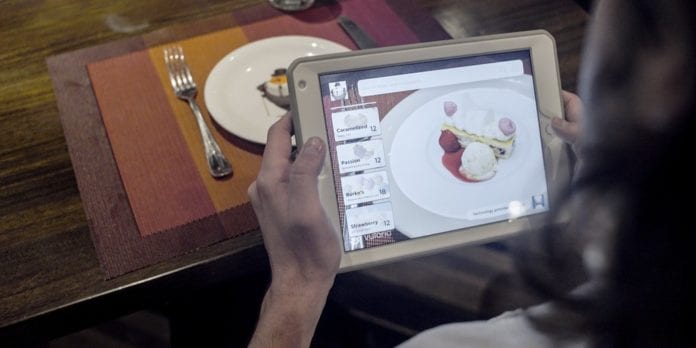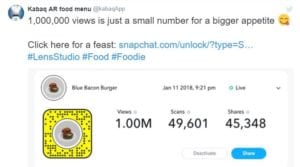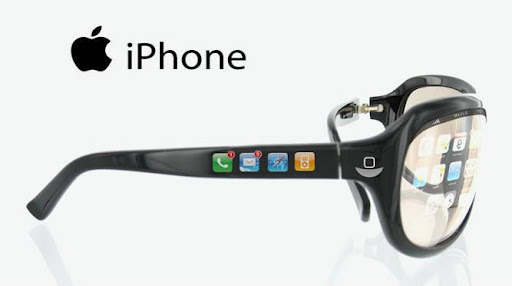International cuisine, no longer the dominated by France is defining choices from high-end restaurants to food trucks. Kabaq, using AR technology cuts the confusion, whets the appetite, and turbo-charges selection with lifelike 3D images – WYSIWYG indeed! Intended for the whole spectrum, it sets clear expectations for diners whatever the setting.
Customers dining in high-end restaurants or ordering online are fully immersed in the experience. In fact, rather than being a passive activity, seeing the presentation makes it easier to ask the maitre d’ (or waitress, if you will) specific questions and is a great ice-breaker – literally food for thought. Choosing for a group with varied tastes is now a snap (pun intended) because the app allows you to virtually populate the table with your preferences. No more over-ordering or waiting for additional dishes after everyone else is done because the estimates fell short. Long story short, it’s great for people who hate surprises! It’s also the best option for the finicky who want their food,”just so”. And did I mention that it’s fun?
“Kabaq enable users to see virtual 3D food on their table in-restaurant and when ordering online.” – KaBAQ
Detractors claim that it puts devices on the table and depersonalizes the dining experience. Others say it’s nothing but a menu on steroids. But Kabaq counters that would be totally missing the point. For the clueless who can’t make a decision based on intimidating menu entries (some of which are printed in a foreign language with vague descriptions), photos help. Notice how ordering Japanese or Chinese food is made infinitesimally easier when they are in full color? However, pictures on the menu don’t give you an idea about serving size. Good for one or good for four are totally relative, but “real-size” as seen on the plate prevents misses. In my experience, I’ve never nailed estimates and either went home hungry or with enough left-over food to feed a basketball team!
The app makes it easy for restaurateurs to explain their menu. Virtual 3-D models, photographed from the restaurant’s own offerings can now be superimposed on the table and their every tasty attribute discussed. In fact, it so effective than Haim Amit, the owner of Vino Levantino in New York claimed that since the restaurant used the app sales increased by 22%, largely due to the greater demand for desserts. Seeing the tasty array makes it easier to upsell orders to higher-priced items like steaks instead of just salads or pasta – and even add on desserts, side dishes, and drinks for a veritable feast.
“Kabaq offers high quality realistic food models for augmented, virtual and mixed reality experiences.” – Alper Guler
Kabaq is the brainchild of Kabaq is the brainchild of Caner Soyer(Head of Content) and Alper Guler(CEO). Founded barely 3 years ago Guler leveraged technologies like Snap’s Lens Studio and Apple’s ARKit. To date one of Kabaq’s biggest clients, the dipndip franchise is already using it through their 100 cafes globally. It is launching two very important campaigns soon: Bareburger, a New-York-based burger joint with 50 locations starting February 2018 and a top-secret project debuting in March. With recent views at 1M for its Blue Burger, this virtual app for real down-to-earth hunger is certainly going places (and filling stomachs)!
“We believe the future of viewing and ordering food will be immersive, within AR, MR and VR environments.” – Kabaq
Alper Guler is optimistic that this technology will be on the rise because visually appealing or “Instagrammable” dishes are the rage, and have been for years. Aside from restaurant menus and online food ordering, Kabaq can be used as a branding tool using the Snapchat platform and can be effectively used for catering presentations. The Snapchat connection augers particularly well for its growth since 40% of users are between 25-40 years old – definitely the foodie market. With more restaurant and chains piloting the app, it won’t be a surprise if Kabaq turns out to be the restaurant menu of the future.
Sources:
What’s On the Menu? Augmented Reality and 3-D Food Models. (2017). VOA. Retrieved 1 February 2018, from https://www.voanews.com/a/augmented-reality-3-d-food-models-on-the-menu/4136235.html
http://www.kabaq.io/


















